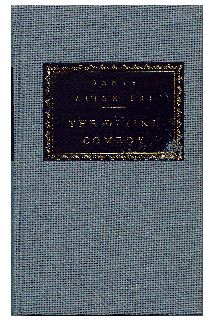
The Divine Comedy
Dante Alighieri
Alfred E. Knopf,1995, 798 pages

|
 ew subjects have fired the imagination of
Westerners as much as the concept of Hell. Dante's allegorical
Inferno is not only a literary masterpiece, but also a window
into the mind of 14th century Christianity and social values in
the late Middle Ages. Dante used his vision of Hell to criticize
the failings of his countrymen; while modern-day readers may be
mildly amused to discover that Hell is full of Italians, Dante
finds people from Genoa and Bologna, city-states that competed
with his native Florence, particularly well-represented
among the ranks of the damned. Dante also reserves a place for
Muhammad and Popes Anastasius and Nicholas III, which reflects
his political views as a White Guelf, a political party which
opposed papal power. This may explain why he also takes a swipe
at the French, who, with the help of Charles of Valois, aided
the Black Guelfs in seizing power in Florence and casting Dante
into exile. Dante reserves the ultimate penalty, however,
for the historical figures Judas, Cassius, and Brutus, who are
condemned to be devoured for all eternity by the mouths of Lucifer
in the icy center of the 9th level of Hell. Unlike the abstract
concepts of hell found in the works of existentialists like
Jean-Paul Sartre, Dante's hell is concrete and visual. The Divine
Comedy trilogy (Inferno, Purgatorio, and Paradiso) is not only a
voyage of discovery and redemption for Dante, but the great
influence this work had on our modern-day literature (especially
T.S. Eliot), on our vision of Christian mysticism and medieval
social values, or for that matter on our modern-day computer
games, attests to the tremendous power of Dante's imagination.
ew subjects have fired the imagination of
Westerners as much as the concept of Hell. Dante's allegorical
Inferno is not only a literary masterpiece, but also a window
into the mind of 14th century Christianity and social values in
the late Middle Ages. Dante used his vision of Hell to criticize
the failings of his countrymen; while modern-day readers may be
mildly amused to discover that Hell is full of Italians, Dante
finds people from Genoa and Bologna, city-states that competed
with his native Florence, particularly well-represented
among the ranks of the damned. Dante also reserves a place for
Muhammad and Popes Anastasius and Nicholas III, which reflects
his political views as a White Guelf, a political party which
opposed papal power. This may explain why he also takes a swipe
at the French, who, with the help of Charles of Valois, aided
the Black Guelfs in seizing power in Florence and casting Dante
into exile. Dante reserves the ultimate penalty, however,
for the historical figures Judas, Cassius, and Brutus, who are
condemned to be devoured for all eternity by the mouths of Lucifer
in the icy center of the 9th level of Hell. Unlike the abstract
concepts of hell found in the works of existentialists like
Jean-Paul Sartre, Dante's hell is concrete and visual. The Divine
Comedy trilogy (Inferno, Purgatorio, and Paradiso) is not only a
voyage of discovery and redemption for Dante, but the great
influence this work had on our modern-day literature (especially
T.S. Eliot), on our vision of Christian mysticism and medieval
social values, or for that matter on our modern-day computer
games, attests to the tremendous power of Dante's imagination.
